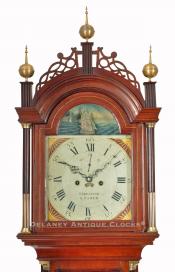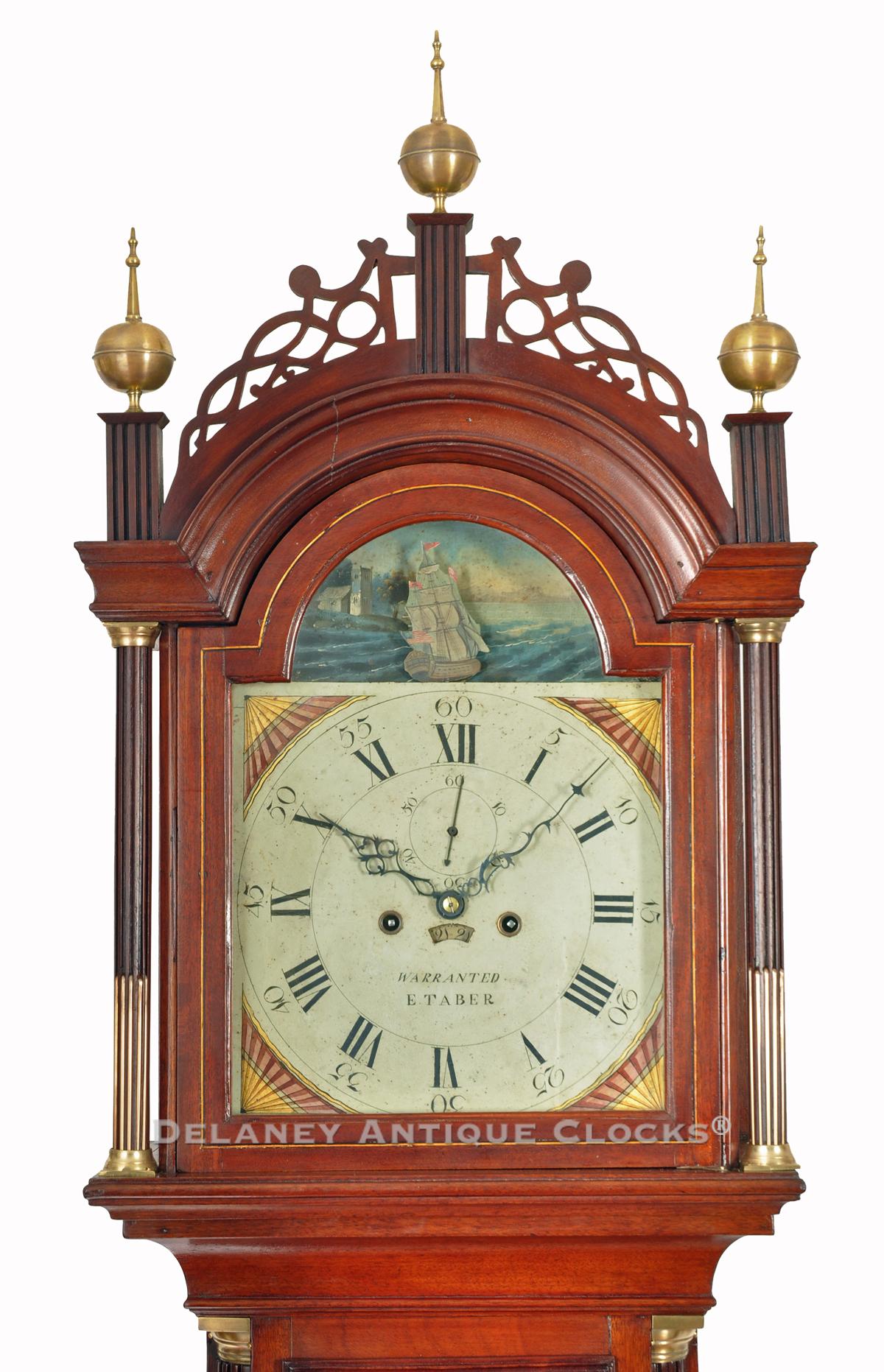Elnathan Taber of Roxbury, Massachusetts. A labeled inlaid mahogany case tall clock featuring a rocking ship automated dial. TT-137.
This is a labeled example. The Clockmaker's paper set up label is pasted to the waist door. This paper label measures approximately 3.5 inches tall and 4 inches wide. It is in good overall condition having some areas of loss around its perimeter. Very few clock cases were initially labeled. Even fewer remain with their cases. This is a very nice piece of the clock's history.
This line inlaid mahogany case stands on four applied ogee bracket feet. These are delicately formed and are secured to a double-stepped molding located at the bottom of the base. The base panel is cross-banded around its perimeter. The wood selected for this cross-banded detail exhibits good striping in the grain. This banding frames a mahogany veneered panel. The grain here features a long sweeping pattern laid out in a vertical format. The sub-structure behind the veneered has moved over time. As a result, the veneer has stretched and now exhibits several age splits. However, they are now stable and add to the character of this beautiful antique. The cross banding and the veneered panel are separated by a simple double line inlay pattern of light and dark stringing. This same pattern is used again in the design of the long rectangular waist door. This waist door is fitted with applied molding along its perimeter. The mahogany veneer selected for this prominent location also features a long vertical grain pattern. The sides of this case are fitted with brass stop-fluted quarter columns. These terminate in brass quarter capitals. The bonnet is a fretwork style surmounted with three ball and spike finials. They are mounted on fluted plinths that are capped at the top. The bonnet columns are brass stop fluted and terminate in brass Doric-shaped capitals. These columns visually support the molded arch molding. The hood sides present tombstone-shaped side windows. These are fitted with glass and provide visual access to the movement. The bonnet door is an arched form and is line inlaid. This door opens to access the wonderfully painted iron dial.
This iron dial is of Boston manufacture and is very colorfully painted. It was most likely painted by Spencer Nolen based on other known signed examples. The four spandrel areas feature geometric designs that are colored in gold, green, and red. The automated feature of a rocking ship is located in the arch of this dial. The painted ship is depicted flying two large American flags. This ship moves or rocks gently from side to side with the pendulum's motion. The painted scene behind the sailing ship includes a large meetinghouse which is built out on a peninsula to the right. This nautical theme is painted on a convex piece of metal which adds to the visual depth to the scene. This is nicely executed. The hours, minutes, seconds, and calendar days are all displayed in a traditional format. This dial is signed by the Maker, "WARRANTED / E. Taber," in large block lettering just below the calendar aperture.
The movement of this clock is constructed in brass and is of very good quality. Four turned pillars support the two brass plates. Hardened steel shafts support the polished steel pinions and brass gearing. The winding drums are grooved. The escapement is designed as a recoil format. The movement is weight driven and designed to run eight days on a full wind. It is a two-train or a time-and-strike design having a rack and snail striking system. As a result, it will strike each hour on the hour. This is done on a cast iron bell which is mounted above the movement.
This beautiful clock was made circa 1805. It stands approximately 8 feet 1 inch tall (97 inches) to the top of the center finial.
Inventory number TT-137.
Elnathan Taber was born in Dartmouth, Massachusetts, on February 14, 1768, and may have died in Dartmouth, Massachusetts, on February 27, 1854, at the age of 86. His grave was moved from Dartmouth to Forest Hills Cemetery in Jamaica Plain on October 29, 1870. His parents were Thomas and Elizabeth (Swift) Taber. Elnathan is the older brother of Stephen Taber, whose fortune helped found Taber Academy in Marion, MA. Both brothers traveled to Roxbury and were trained as clockmakers by the Willards. Elnathan was just 16. After serving his apprenticeship, Elnathan stayed and worked in Roxbury. His shop was located on Union Street. Union Street was renamed Taber Street in April 1868 in his honor. He was the first resident of that street. William Cummens also moved there and set up shop at the corner of Winslow. This short street was between Warren Street and Winslow Street. Elnathan maintained a close working relationship with his mentor Simon and became one of his most famous apprentices. He was authorized by Simon to make his patent timepieces during the patent period. He was also a prolific repairman. His name can be found engraved on numerous Boston area-made clocks as a service record. Elnathan married Catherine Partridge in January 1797. They had four children between the years of 1797 and 1811. Catherine had three sisters who also married clockmakers. Her sister Elizabeth married Abel Hutchins, and Mary (Polly) married Aaron Willard. A third sister married Samuel Curtis. Over the years, we have owned and sold numerous tall case clocks made by this fine clockmaker. In addition, we have owned a good number of wall timepieces in the form of banjo clocks and coffin clocks, as well as several of the Massachusetts shelf clock forms.










